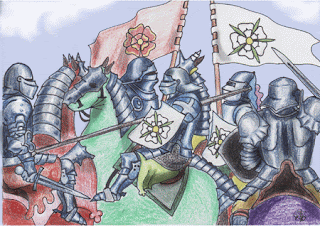Ok, let’s switch gears for a second. We are agreed that the culture of Westeros in
George R.R. Martin’s “Song of Ice and Fire” series has some pretty stark (pun
intended) correlations to that of Great Britain, yes? I’m thinking the rough shape of the country,
the wall dividing the country proper from the savages in the extreme north, the
knights, the sigils, the feudalism, the fact that the country is made up of
several united kingdoms, etc etc.
Well, as I was reading Richard III, I started to notice
some things that were similar to events in “A Song of Ice and Fire.” Attend:
Richard III is about the eponymous Richard, Duke of
Gloucester, and how he eventually (temporarily) comes out on top in the Wars of
the Roses and is king of England for a few years, before dying in battle against the guy who will become the first Tudor king, Henry VII.
He plots skillfully, uses people and then betrays them, and has them
assassinated or executed. The plot of
the play isn’t terribly similar to that of “A Song of Ice and Fire,” but the
details—some events, some names, some sigils—are. Here are some:
--The reason this civil war is called the Wars of the Roses
is because the two main families battling for control of the throne, the
Lancasters and the Yorks, both had roses as their sigils. The Lancasters were red roses, the Yorks
white. (Reminds me of the Tyrells)
--At the beginning of the play, the king, Edward, dies. There are two very young princes who are
potential heirs, and Richard is appointed Lord Protector and has them
sequestered in royal apartments in the Tower of London “to keep them safe.” Instead, to remove them as an obstacle between him and
the throne, he has them killed (brutally) by a dude named Sir James Tyrrell.
--A guy gets drowned in a barrel of wine. (remind you of Ser
Dontos?)
--The Earl of Richmond, Henry, eventually becomes king. He’s
the wholesome, noble guy who has been off in exile and has returned to claim the
throne as the preferable alternative to Richard III.
So, yeah. I may be
stretching, but some of these are kind of uncanny. I don’t think I’m suggesting that Martin is
drawing from this play in particular, but I definitely think he’s drawing from
British history. The War of Five Kings
and the Wars of the Roses are rather similar.
What do you think?
All of that was terribly confusing for me to try to summarize, (civil
wars are complicated, and EVERYONE in the British nobility is named Henry or
Edward), so were things sufficiently explained for you?
Love, Dory
